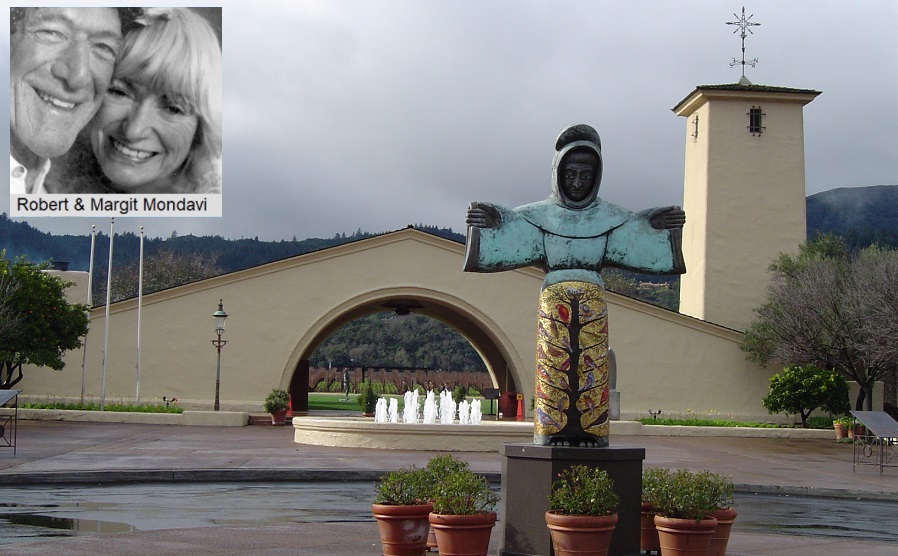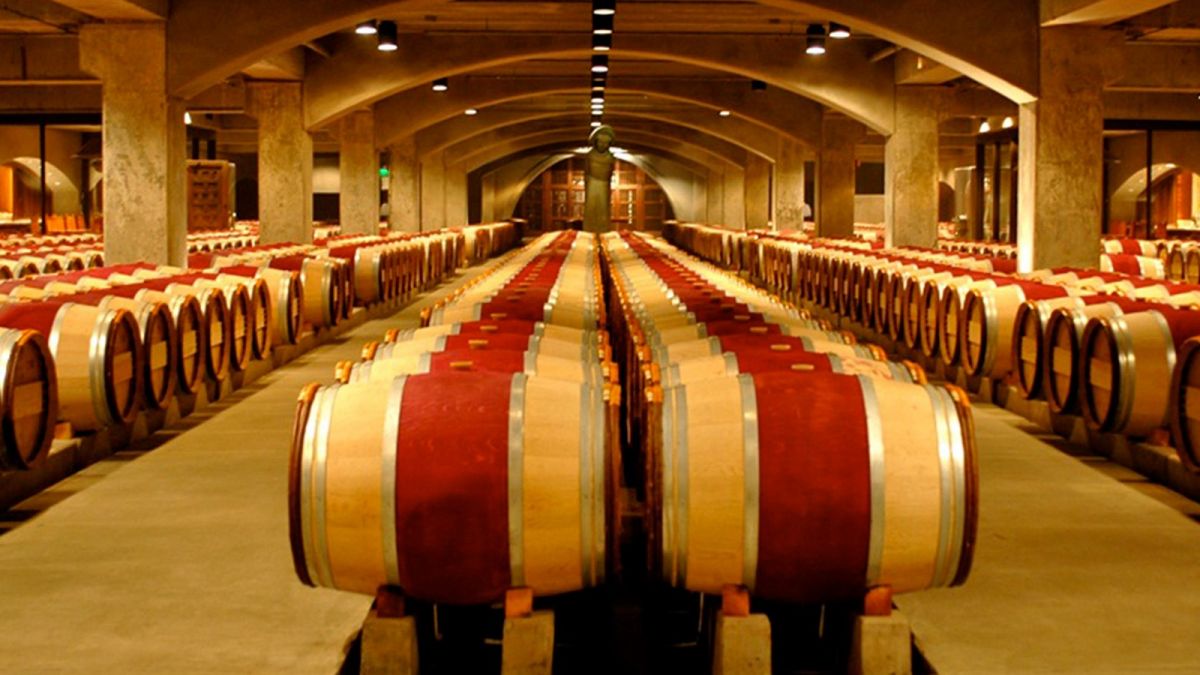The success story of what is probably California's most famous winemaking family began when Cesare Mondavi (1883-1959) emigrated from the Marche region to Virginia in the US state of Minnesota in 1906 and his wife Rosalia Angela (1890-1976) two years later. After a brief career in iron mining, Cesare opened a saloon. The family expanded with the addition of two sons, Robert Gerald (1913-2008) and Peter Rudolph (1914-2016). In 1922, the family moved to California and established a wholesale grape business in Lodi in the Central Valley. Wine was also produced for their own use. In 1943, the winery founded in 1861 by Charles Krug (1825-1892) was purchased for $75,000. The two sons shared the responsibility, Robert was responsible for marketing and Peter for the vineyards and vinification. They were assisted by the famous oenologist André Tchelistcheff (1901-1994).

Separation of the Mondavi brothers
Charles Krug Winery was the first winery in the USA to introduce temperature-controlled fermentation. After the death of their father in 1959, the two brothers fell out. The main reason was that the two could not agree on the direction and future of the winery. In 1965, it escalated to an alleged physical altercation between the two (only 40 years later, there was a reconciliation in 2005). Robert Mondavi then founded the "Robert Mondavi Winery" in Oakville in Napa Valley with his son Michael in 1966. This was the first new winery to be founded in Napa Valley since Prohibition (1920-1933). The buildings were designed in the Spanish mission style with a bell tower. Peter Mondavi continued to run Charles Krug Winery alone with his mother Rosa.

The Mondavi Empire
The winery is based on a four-acre portion of the To Kalon vineyard in the Oakville area, acquired at the time of its founding. Additional vineyards were acquired in 1969 at the Wappo vineyard in the Stags Leap area and in 1988 at the Huichica Hills vineyard in the Los Carneros area. The Mondavi Winery subsequently became the Californian and also the American benchmark with regard to completely new cultivation methods and cellar techniques. Particular experiments were made in barrique age ing, which Robert Mondavi specifically explored after a visit to Europe. The famous "Fumé Blanc" was created, a dry white wine from Sauvignon Blanc (in the Loire "Blanc Fumé") that was matured in barriques.
Today, top wines are also produced from the red wine varieties Cabernet Franc, Cabernet Sauvignon, Merlot, Petit Verdot and Pinot Noir, as well as the white wine varieties Chardonnay, Riesling and Sémillon, among others. Consistent "natural winegrowing/farming" (with European standards of organic viticulture) has become the defining Mondavi philosophy since 1970. Nevertheless, the most modern, innovative production methods are used, which in the meantime have become popular with many other large farms under the name of precision viticulture. For example, satellite imagery is used to determine the heat levels of different vineyards in order to determine the optimal ripening times for the grapes. Biotopes and forest patches are planted in the vineyards, and nesting birds are expressly encouraged.
Today, the Mondavi empire consists of a dozen different labels and companies that are connected in confusing and different ways. These are the parent company and headquarters Robert Mondavi Winery (Oakville, Napa Valley), Robert Mondavi Coastal, La Famiglia di Robert Mondavi and Colmera, the former cooperative winery Woodbridge in the town of the same name, bought in 1979, the Arrowood Vineyards & Winery with the two labels Arrowood and Grand Archer (Glen Ellen, Sonoma County), bought in 2000, and the Vichon Mediterranean winery in the French Languedoc, founded in 1997. In addition, there are holdings in Chile (joint venture with the Chadwick family, see Errázuriz) and in the Australian Rosemount Estate (joint venture with the Oatley family). Together with Baron Philippe de Rothschild (1902-1988), the owner of Château Mouton-Rothschild, Robert Mondavi started the 50:50 joint venture Opus One with the top red wine of the same name in Napa Valley as early as 1979.
The vineyards cover a total of 1,300 hectares of vines, including long-standing contract vineyards. The wines are produced under different labels with different qualities or price ranges. The majority are varietals (single varietals). Under Woodbridge, about 75 million bottles are produced annually, which is about three quarters of the wines. This brand represents the lowest price segment. The Twin Oaks series, also produced there, is the higher class. Low-priced Californian varietal wines are marketed under Coastal Wines (8.5 million bottles). Under Io, wines are vinified in the Rhône style (Syrah). Under Vichon, young wines from the Languedoc are vinified in the Oakville winery (5 million bottles). And under the label La Famiglia di Robert Mondavi, wines are produced from Italian varieties grown in California. In total, the Mondavi empire produces 100 million bottles of wine annually.
Retreat of Robert Mondavi
From the mid-1980s onwards, Robert Mondavi gradually withdrew from day-to-day business, but retained the function of "brand ambassador". Among other things, he represented the company in the family wineries association PFV (Primum Familiae Vini). However, Mondavi had to leave this illustrious circle in 2005 when the company was sold to Constellation Brands. His memoirs were published in 1999 under the title "Harvest of Joy". Together with his wife Margrit, he founded the "Galeria Copia" as the "American Center of Wine, Food and the Arts" as the main sponsor in the city of Napa in 2001. The aim was to show the public that wine and food can influence culture and contribute to the quality of life.
Robert Mondavi thus created a monument for himself during his lifetime. In 1994, he appointed his son Michael as Chief Executive Officer, son Timothy as Managing Director and daughter Marcia as a director. At the same time, the company was converted into a listed public limited company. A major renovation programme for the Napa Valley estate was launched in 1991. By 2001, a modern winery had been built, retaining the original architecture, in which the grapes are moved by gravity alone without pumps, gently pressed using basket press es and fermented in French oak barrels.
major changes
In the late 1990s, sales problems arose, especially for the high-priced top brands, causing major changes. After Timothy Mondavi withdrew from the management in 2003 due to internal family disputes, Ted Hall (who came from the consulting firm McKinsey) was appointed chairman for the first time in January 2004 and Michael Mondavi was demoted to second-in-command. One hundred employees were dismissed. In mid-2004, the Mondavis' shareholding was reduced by conversion from 85 to 40%. Shortly afterwards, Michael Mondavi also resigned from the board as vice-president. The family era was drawing to a close.
There were rumours that Mondavi was to be split up and that it would only concentrate on the production of inexpensive consumer wines under 15 dollars a bottle. Above all, the parent company, the Arrow and Byron wineries, as well as the holdings in California, Italy and Chile were to be sold off. In December 2004, Mondavi was finally taken over by the Constellation Brands wine group. The reported purchase price of 1.36 billion dollars illustrates the size of the deal. This caused some structural changes. For example, the former participation in the wineries Luce della Vita and Ornellaia in Italy was abandoned and both were now completely taken over by the former partner Frescobaldi.
Building: By Geographer, Public Domain, Link
R.and M. Mondavi: By Julia Flynn Siler - The House of Mondavi, Fair use, Link
Barrique cellar: Robert Mondavi Winery
Voices of our members

As honorary chairman of the Domäne Wachau, it is the easiest and quickest way for me to access the wein.plus encyclopaedia when I have questions. The certainty of receiving well-founded and up-to-date information here makes it an indispensable guide.
Hans-Georg Schwarz
Ehrenobmann der Domäne Wachau (Wachau)